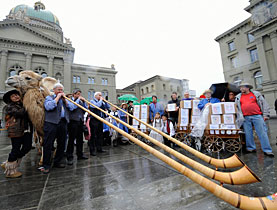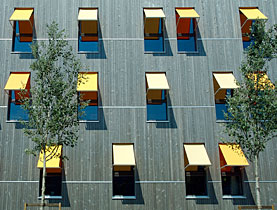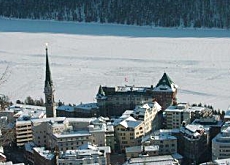Green light for academic’s dream eco home

A Swiss university professor has been given the go-ahead to build a model apartment block that will combine unique new CO2-free technologies.
The building, with four apartments, is the brainchild of Professor Hansjürg Leibundgut, chair of the Building Systems department at the Federal Institute of Technology in Zurich.
The permission granted by the Zurich City Council will enable him to fulfil a long held dream.
Leibundgut says that while carbon neutral houses already exist in Switzerland, this complex will be both green and include affordable technologies.
Although research for the project was done at the university, Leibundgut is taking a chance and putting it into practice by funding the development himself. He will also live in one of the apartments.
“We know that about half of carbon emissions are emitted from houses. We also know that there is a possibility of reducing this to zero as soon as we produce electricity to drive the house. So we have to combine this,” he told swissinfo.
“We are integrating about ten new innovative things. About five of them have never been done before and are in development and production in different Swiss firms.”
In particular, he believes the house’s heating and cooling systems and solar energy storage will be the first of their kind in a private home.
Sicilian temperatures
Everything in the new building will run on solar and wind-powered electricity. The technologies include a method of recovering heat from waste water and windows which let through a lot of light while still retaining heat.
A network of pipes will be installed in the outer wall of the building and covered with 4-cm thick thermal insulation. Water circulating in the pipes will exchange heat between the building and the ground.
In the summer the building will be cooled by the circulating water system absorbing the heat and passing it into the ground. In the winter, the energy stored deep underground will be used to heat the water circuit to about 15 degrees Celsius and then to heat the network of pipes in the walls. Without the need for extra heating the house would become CO2 free.
“In winter the inner brick wall will make the house feel as if it was in Sicily,” said Leibundgut.
“This is a good opportunity. If you have an existing house with a certain kind of architecture you cannot do this or you would destroy the look of the building.”
The foundations of the building will be like a standard 1960s home. Leibundgut figures the additional technologies will cost an extra SFr40,000 ($34,300) for each apartment on top of normal building costs.
Common goal
Leibundgut’s team first presented their research into the model house in February as part of their work to find a way of cutting down on CO2 emissions in Switzerland.
Planning permission was finally given by the city after a deadline passed for appeals against the proposal. The land is being acquired and construction is expected to start in April 2009, with completion due in June 2010.
Leibundgut will select the other residents, all of whom will pay SFr300 a month toward the sustainable technologies.
“I want to have nice people because they will share something in common. We have a certain responsibility for what we want the house to show.”
He is so convinced the project will work that he is pouring his life savings into it.
“It’s all the money I have, [if it fails] I will become bankrupt. But I don’t think that it will happen.”
swissinfo, Jessica Dacey
Carbon dioxide (CO2) is one of the major gases responsible for greenhouse effect and global warming. In Switzerland it represents around 80% of harmful emissions.
The other gases include methane, nitrous oxide and hydrocarbons.
Despite ambitious emission targets, greenhouse gas emissions have actually risen by 0.4% in Switzerland since 1990.
The house at Bolleystrasse in Zurich will house four families and include a cellar and underground parking.
The building will integrate new technologies in development from 2006 to 2010.
Innovations include:
Solar and wind power.
Insulation that aims to maintain internal temperature.
Recycled waste water to generate heat.
Adaptable ventilation.
Bigger and better windows to cut down on artificial lighting.

In compliance with the JTI standards
More: SWI swissinfo.ch certified by the Journalism Trust Initiative




You can find an overview of ongoing debates with our journalists here . Please join us!
If you want to start a conversation about a topic raised in this article or want to report factual errors, email us at english@swissinfo.ch.